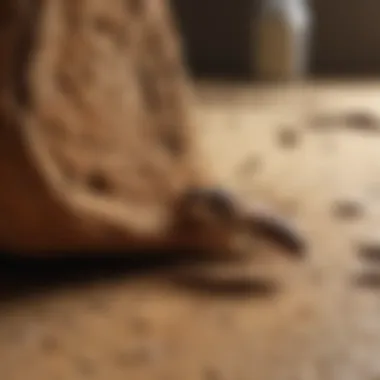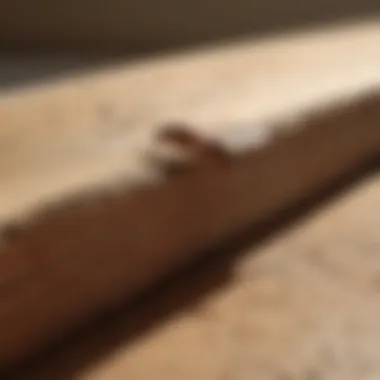Materials:
To effectively conduct a termite inspection, you will require the following materials:
- Flashlight: Ensure proper visibility in dark areas and corners where termites might hide.
- Screwdriver: Useful for tapping on wood and detecting hollow sounds which could indicate termite infestation.
- Protective gear: Gloves and a mask to shield yourself from potential termite contact and harmful chemicals.
- Moisture meter: To detect excess moisture levels in wood, which attract termites to infest.
DIY Steps:
- Preparation: Start by ensuring all areas to be inspected are accessible and free of clutter. Clear pathways around the house for easy movement during the inspection.
- Indoor Inspection: Begin the inspection indoors, checking around windows, doors, baseboards, and other wooden structures. Use the flashlight and screwdriver to detect any signs of termite activity.
- Outdoor Inspection: Move outdoors to inspect the foundation, porch, deck, and any wooden structures in the yard. Look for mud tubes, discarded wings, and sagging wood, indicating termite presence.
- Moisture Check: Utilize the moisture meter to assess moisture levels in wooden structures. High moisture content attracts termites, making these areas prime targets for infestation.
Technical Aspects:
- Tools: Ensure your flashlight and screwdriver are high quality and functioning optimally for accurate detection.
- Timing: Conduct inspections during the day when termites are most active and visible.
- Techniques: Tap lightly on wood surfaces with the screwdriver to listen for hollow sounds, a common indication of termite presence.
Sequential Steps:


- Start with a thorough indoor inspection, moving systematically from room to room, checking all wooden elements for signs of termites.
- Proceed to the outdoor inspection, paying close attention to areas where wood contacts soil as termites often access homes from the ground.
- Check for moisture levels in wooden structures and address any areas with high moisture promptly to prevent termite attraction.
Troubleshooting Tips:


- If you find evidence of termites, consult with a professional pest control service immediately to address the infestation.
- Regularly monitor and maintain low moisture levels in and around your home to deter termite activity.
Factors Impacting Termite Test Cost


Termite inspections are crucial for homeowners to prevent costly damage to their properties. Understanding the factors that influence the cost of these inspections is essential for making informed decisions. When it comes to the cost of termite inspections, several key elements play a significant role in determining the overall expenses. Factors such as the severity of the infestation, the size of the property, the type of inspection chosen, and the location of the property all contribute to the final cost. By delving into these factors, homeowners can better grasp the financial aspects involved in protecting their homes from termite damage.
Severity of Infestation
When considering the cost of termite inspections, the severity of the infestation is a critical factor. Early detection costs are associated with catching termite issues in their initial stages, which can help minimize damage and treatment expenses. On the other hand, extensive infestations require more extensive and costly remedies to eradicate the termites and repair the resulting damage. Understanding the difference between early detection costs and expenses related to extensive infestations is key to managing the overall cost of termite inspections.
Property Size
The size of the property also influences the cost of termite inspections. Small homes typically require less time and resources for inspection compared to large estates. However, larger properties may have more areas that need to be thoroughly examined for termite activity, leading to higher inspection costs. Evaluating the size of the property in relation to the potential termite threat can help homeowners estimate the inspection expenses more accurately.
Type of Inspection
Choosing the type of inspection is another factor that impacts the cost of termite inspections. Visual inspections are a standard method used to detect termite presence, while advanced technologies such as infrared cameras and moisture meters offer more in-depth analysis but come at a higher price. Deciding on the most suitable inspection approach based on the property's needs and budget is crucial for optimizing the cost-effectiveness of termite inspections.
Location
The location of the property also plays a role in determining the cost of termite inspections. Urban areas may have higher inspection fees due to the prevalence of termite infestations and the increased demand for pest control services. In contrast, rural settings might have lower inspection costs but could face challenges related to accessing specialized treatment options. Considering the location-specific factors that influence termite inspections is essential for homeowners to budget effectively for these vital maintenance procedures.
Average Cost Ranges
Understanding the cost associated with termite inspections is crucial for homeowners seeking to protect their properties. When considering termite inspection costs, several factors come into play, including the extent of the infestation, the size of the property, the type of inspection needed, and the location of the property. These elements collectively determine the overall cost that homeowners can expect to pay for termite inspections. By understanding the average cost ranges, individuals can make more informed decisions regarding their pest control needs. By delving into the specifics of average cost ranges, homeowners gain insight into the financial implications of termite inspections, allowing them to budget effectively and prioritize the protection of their homes.
Baseline Inspections
Baseline inspections serve as the foundational step in assessing the presence of termites in a property. Typically, these inspections involve a thorough visual examination of the premises to identify any visible signs of termite activity. The cost of baseline inspections primarily depends on the size of the property and the severity of the infestation. During baseline inspections, professionals look for common indicators of termite infestations, such as mud tubes, damaged wood, and termite droppings. Homeowners can expect to pay a moderate fee for these initial inspections, which provide essential information for further pest control measures.
Comprehensive Checks
Comprehensive termite checks entail a detailed assessment of the property to identify any hidden termite infestations or vulnerabilities. These inspections typically involve advanced technologies such as thermal imaging and moisture meters to detect termites beneath the surface. The cost of comprehensive checks varies depending on the complexity of the inspection and the size of the property. While these inspections may come at a higher price point, they offer a more thorough evaluation of termite activity and potential risks within the property. Homeowners should consider the benefits of comprehensive checks in terms of long-term termite prevention and property preservation.
Additional Treatments
In addition to inspections, homeowners may require additional treatments to address existing termite problems or prevent future infestations. These treatments can include termite baiting systems, chemical barrier treatments, or fumigation strategies. The cost of additional treatments depends on factors such as the type of treatment selected, the size of the property, and the severity of the infestation. By investing in these additional treatments, homeowners can protect their homes from termite damage and ensure long-term peace of mind. Considering the potential costs of termite damage repairs, preventive treatments are a proactive measure to safeguard the structural integrity of the property.
Choosing the Right Inspection Service
In the realm of termite inspections, selecting the appropriate inspection service stands paramount in ensuring the structural integrity of one's abode. The choice of inspection service significantly influences the efficacy of the inspection process and subsequent preventive measures. Homeowners must meticulously weigh key factors such as the experience and reputation of the service provider, the comprehensiveness of the inspections offered, and the range of treatments available when deciding on the right inspection service.
Experience and Reputation
Reputation and experience are linchpin factors when engaging an inspection service provider for termite infestation assessments. Industry certifications serve as a benchmark for evaluating the technical expertise and competency of the service provider. These certifications not only affirm the professionalism and adherence to industry standards but also denote a commitment to quality service delivery. Opting for a certified service provider ensures that the inspection process is conducted meticulously, adhering to best practices endorsed by industry regulatory bodies. By choosing a certified inspection service, homeowners can rest assured that their property is in the hands of trained professionals equipped with the knowledge and skills to detect and address termite infestations effectively.
Customer Reviews
Customer reviews offer invaluable insights into the service quality and customer satisfaction levels of inspection service providers. Real-time feedback from previous clients provides prospective customers with a glimpse into the service provider's reliability, punctuality, and overall customer service. Positive reviews underscore the service provider's commitment to client satisfaction and highlight successful outcomes in terms of termite detection and treatment. On the contrary, negative reviews signal potential drawbacks such as delays, inadequate treatments, or unsatisfactory customer service. Scrutinizing customer reviews empowers homeowners to make informed decisions when selecting an inspection service, enabling them to choose a provider with a proven track record of excellence and customer-centric service delivery.
Service Inclusions
Guarantees Provided
Guarantees extended by inspection service providers instill confidence in homeowners regarding the effectiveness of the treatments and the durability of prevention measures. These guarantees commonly cover aspects such as treatment effectiveness, re-infestation protocols, and damage reimbursement policies. A service provider offering substantial guarantees reflects a commitment to service excellence, assuring customers of reliable solutions and prompt remedial actions in case of termite resurgence. Homeowners should carefully review and understand the terms and conditions of the guarantees provided, ensuring clarity on the extent of coverage and the procedures to follow in case of termite-related incidents.
Follow-up Inspections
Follow-up inspections play a pivotal role in the post-treatment phase, ensuring the long-term efficacy of preventive measures and detecting any early signs of termite activity. Scheduled follow-up inspections enable service providers to assess the impact of treatments, monitor termite activity levels, and recommend additional measures if necessary. Regular follow-up inspections reassure homeowners of the sustained protection of their property against termite infestations, minimizing the risk of structural damage and costly repairs. By incorporating follow-up inspections in their service offerings, inspection providers exhibit a commitment to proactive termite management and customer satisfaction, fostering long-term relationships grounded in trust and quality service provision.
Comparing Quotes
When contemplating termite inspections, comparing quotes from multiple service providers plays a pivotal role in selecting a cost-effective and reliable inspection service. The process of comparing quotes involves evaluating the scope of inspections, the range of treatments included, and the overall cost transparency offered by service providers. An in-depth comparison of quotes enables homeowners to discern value propositions, assess service quality against pricing, and make an informed decision based on their budget and inspection requirements. By soliciting and analyzing quotes from different inspection services, homeowners can ascertain the competitive pricing landscape, negotiate favorable terms, and secure comprehensive termite inspection services tailored to their property's specific needs.





